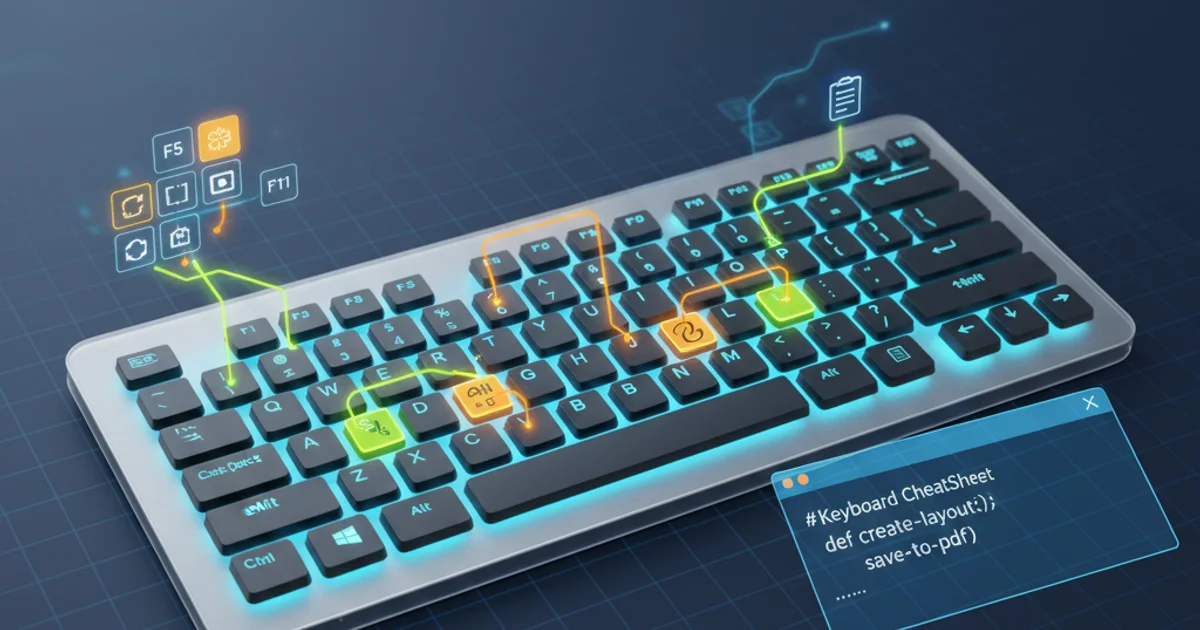Program for creating a Keyboard "CheatSheet"
Categories:
Create Your Own Keyboard Cheat Sheet with LaTeX

Learn how to design and generate a custom keyboard cheat sheet using LaTeX, perfect for remembering complex shortcuts and keybindings.
Keyboard cheat sheets are invaluable tools for developers, power users, and anyone looking to master their applications. They provide a quick reference for shortcuts, keybindings, and commands, boosting productivity and reducing the need to memorize every detail. This article will guide you through creating your own customizable keyboard cheat sheet using LaTeX, a powerful typesetting system known for its high-quality output.
Why LaTeX for Cheat Sheets?
LaTeX offers unparalleled control over document layout and typography, making it an excellent choice for creating visually appealing and highly structured cheat sheets. Its declarative nature allows you to define the structure once and focus on the content, ensuring consistency across your document. Furthermore, LaTeX's ability to handle complex tables and custom commands simplifies the process of organizing keyboard shortcuts effectively.
flowchart TD
A[Define Cheat Sheet Goal] --> B{Choose LaTeX Packages}
B --> C[Structure Document (sections, tables)]
C --> D[Input Keybindings & Descriptions]
D --> E{Compile with LaTeX}
E --> F[Review & Refine Layout]
F --> G[Generate PDF Cheat Sheet]Workflow for creating a keyboard cheat sheet with LaTeX.
Setting Up Your LaTeX Document
To begin, you'll need a basic LaTeX document structure. We'll use the article document class and include a few essential packages. The geometry package helps manage page margins, tabularx is excellent for flexible tables, and xcolor allows for color customization. For keyboard-specific symbols, you might consider packages like fontawesome or custom commands to render key presses.
\documentclass[a4paper,10pt]{article}
\usepackage[margin=1in]{geometry}
\usepackage{tabularx}
\usepackage{xcolor}
\usepackage{amsmath} % For text in math mode
\usepackage{amssymb} % For symbols like \checkmark
% Custom command for key presses
\newcommand{\key}[1]{\texttt{\textbf{#1}}}
\begin{document}
\title{My Custom Keyboard Cheat Sheet}
\author{Your Name}
\date{\today}
\maketitle
\section*{General Shortcuts}
\begin{tabularx}{\textwidth}{|l|X|}
\hline
\rowcolor{lightgray!20} \textbf{Shortcut} & \textbf{Description} \\
\hline
\key{Ctrl} + \key{C} & Copy selected text \\
\key{Ctrl} + \key{V} & Paste copied text \\
\key{Alt} + \key{Tab} & Switch between open applications \\
\hline
\end{tabularx}
\end{document}
Basic LaTeX structure for a keyboard cheat sheet.
Organizing Shortcuts with Tables
Tables are the backbone of any good cheat sheet. LaTeX's tabularx environment is particularly useful because it allows you to define columns that automatically adjust their width to fit the page, making your cheat sheet responsive and readable. You can categorize your shortcuts by application, function, or any other logical grouping using sections and subsections.
\subsection*{Editor Specific Shortcuts}
\begin{tabularx}{\textwidth}{|l|X|}
\hline
\rowcolor{cyan!10} \textbf{Shortcut} & \textbf{Description} \\
\hline
\key{Ctrl} + \key{S} & Save current file \\
\key{Ctrl} + \key{Z} & Undo last action \\
\key{Ctrl} + \key{Shift} + \key{P} & Open command palette \\
\hline
\end{tabularx}
\subsection*{Navigation}
\begin{tabularx}{\textwidth}{|l|X|}
\hline
\rowcolor{green!10} \textbf{Shortcut} & \textbf{Description} \\
\hline
\key{Home} & Move cursor to beginning of line \\
\key{End} & Move cursor to end of line \\
\key{Ctrl} + \key{Left Arrow} & Move cursor one word left \\
\hline
\end{tabularx}
Example of organizing shortcuts into subsections using tabularx.
kbordermatrix package or define custom commands that render keys with borders or specific fonts.1. Install LaTeX Distribution
Download and install a LaTeX distribution like TeX Live (for Linux/Windows) or MacTeX (for macOS). This provides the necessary compiler and packages.
2. Create a .tex File
Open a text editor or LaTeX IDE and save a new file with a .tex extension (e.g., cheatsheet.tex).
3. Add Document Structure
Copy the basic LaTeX structure provided in the examples into your .tex file, including the documentclass and usepackage commands.
4. Populate with Shortcuts
Fill in your desired keyboard shortcuts and their descriptions within the tabularx environments. Organize them logically using sections and subsections.
5. Compile the Document
Use your LaTeX compiler (e.g., pdflatex cheatsheet.tex from the command line, or the compile button in your IDE) to generate a PDF.
6. Review and Print
Open the generated PDF, review the layout and content, and print it out for easy access next to your keyboard.